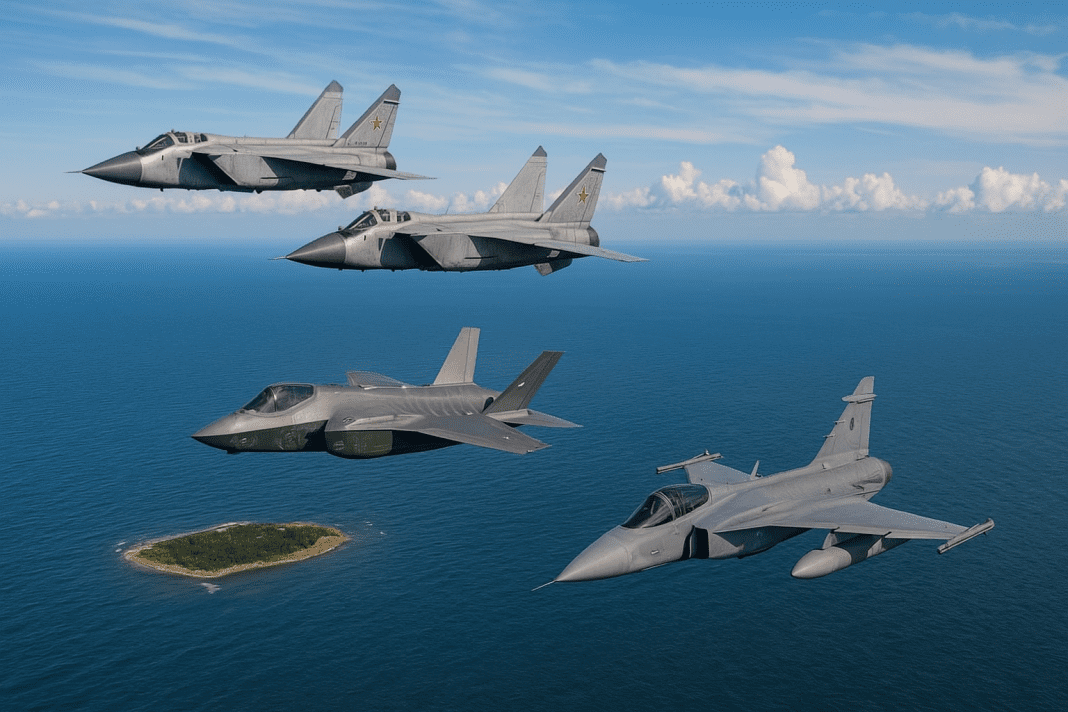In a tense military incident over the Baltic Sea today, three Russian MiG-31 fighter jets entered Estonian airspace near Vaindloo Island without permission. The jets remained inside Estonian airspace for nearly 12 minutes.
Bold Intrusion Over Estonian Airspace and Baltic Skies
Officials described this violation as “unprecedentedly brazen,” highlighting the fact that all three aircraft entered NATO airspace simultaneously in a coordinated formation.
This event marks the fifth airspace violation over Estonian airspace this year, indicating a pattern of military provocations in the region. The unauthorized entry triggered an immediate response from NATO forces. Two Italian F-35A Lightning II fighters were scrambled to intercept the Russian jets. Alongside them, Swedish JAS 39 Gripen fighters also took off to monitor and track the MiG-31 aircraft. Both NATO fighter types maintained visual contact with the Russian jets throughout the operation, demonstrating rapid response capabilities and readiness to defend allied airspace.
⚔️🕊️ Estonia Mobilizes for War: NATO’s Smallest Giant Stands Tall Against Russian Aggression
The incident underscores the strategic importance of Estonian airspace and the broader Baltic region, where NATO members closely monitor military activity to ensure territorial security. The Russian aircraft’s coordinated maneuvers suggest a high level of planning and precision, emphasizing the potential risks associated with airspace violations near alliance territories.
Inside the Russian MiG-31 Foxhound in Estonian Airspace
The MiG-31, known by its NATO reporting name “Foxhound,” serves as a supersonic interceptor designed for long-range and high-altitude missions. It can reach a maximum speed of Mach 2.83, making it one of the fastest combat jets in service today. The aircraft operates at a service ceiling of 20,600 meters, allowing it to engage targets at extremely high altitudes.
Advanced radar systems enable the MiG-31 to track multiple targets simultaneously. It typically carries long-range R-33 missiles to intercept enemy aircraft such as bombers and cruise missiles. Reports indicate that the MiG-31 jets involved in today’s Estonian airspace incident may carry Kinzhal ballistic missiles, giving them a significant offensive capability.
Crypto mining scam worth $577 million ends with prison for Estonian duo
The aircraft operates with a two-person crew and can cover a range of 3,000 kilometers when fitted with external fuel tanks. Its primary mission is interception, making it a crucial component of Russia’s air defense system, particularly for rapid response against airborne threats near its borders.
NATO Interceptors: F-35 Lightning II and JAS 39 Gripen
The Italian F-35A Lightning II fighters dispatched to Estonian airspace represent advanced fifth-generation multirole stealth technology. These jets can reach speeds of Mach 1.6 and operate at altitudes up to 15,240 meters. The F-35’s design focuses on stealth, reducing its radar visibility, while advanced sensor fusion allows pilots to detect and track multiple targets efficiently.
In addition, the F-35 features an internal weapons bay that can carry missiles and other ordnance without compromising its stealth capabilities. The aircraft is integrated with electronic warfare systems and network-centric combat technology, making it a versatile platform for both offensive and defensive air missions.
Sweden’s JAS 39 Gripen fighters also played a key role in today’s interception. Known for their multirole capability, the Gripen jets can perform fighter, attack, and reconnaissance missions. They can reach speeds of Mach 2.0 and operate at a service ceiling of 15,240 meters, with a range of 3,200 kilometers using external fuel tanks.
Estonia Strikes with Explosive Force Despite Menace
The Gripen’s design allows for short takeoff and landing, making it highly adaptable for operations from smaller airbases. Its advanced avionics and radar systems, combined with NATO-compatible technologies, ensure effective coordination with allied forces during rapid Estonian airspace defense operations. Additionally, the Gripen is recognized for cost-effective maintenance, allowing sustained operational readiness without extensive resources.
The combined deployment of F-35 and Gripen fighters illustrates NATO’s capability to respond quickly to airspace violations. Maintaining continuous visual contact with the intruding MiG-31 jets ensured the situation remained under close surveillance, highlighting the alliance’s coordinated air defense efforts in Estonian airspace.
